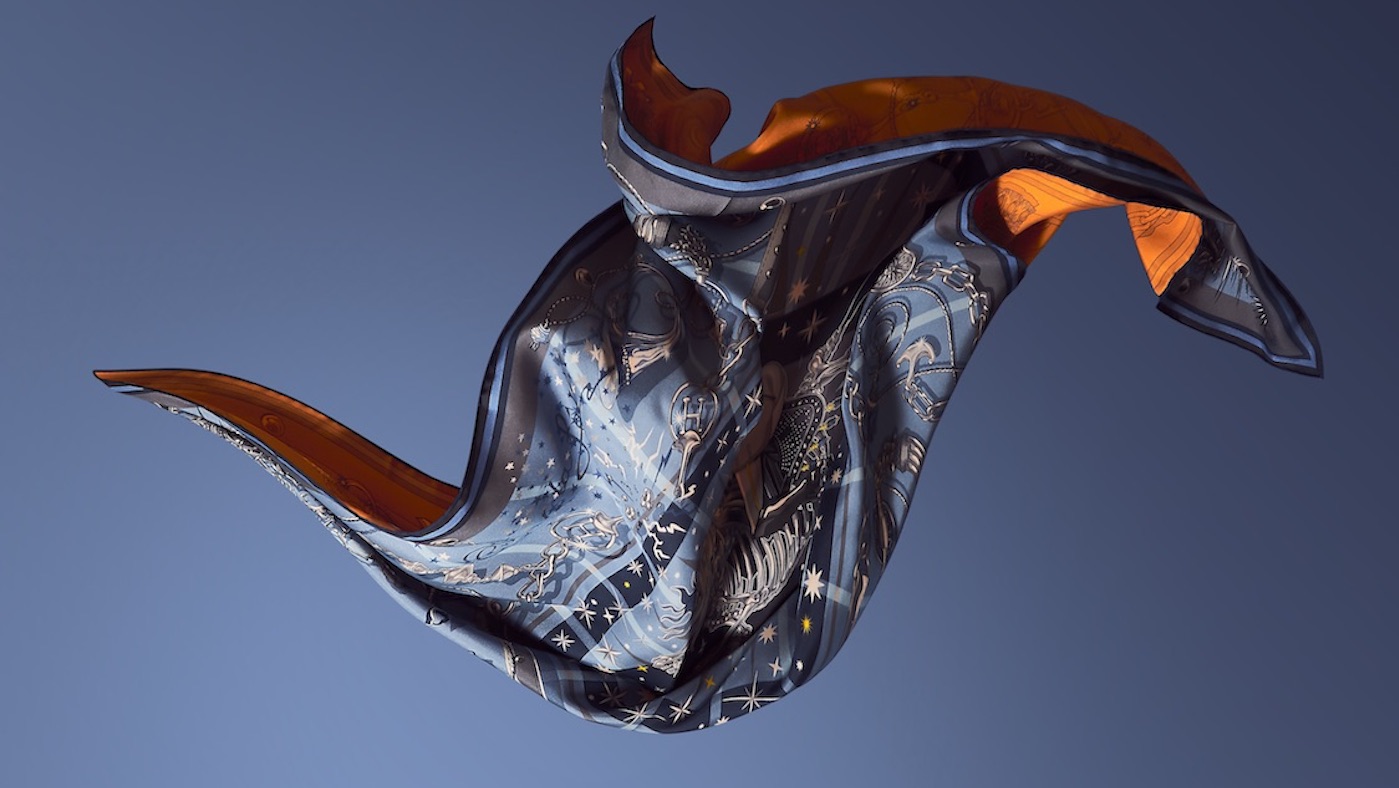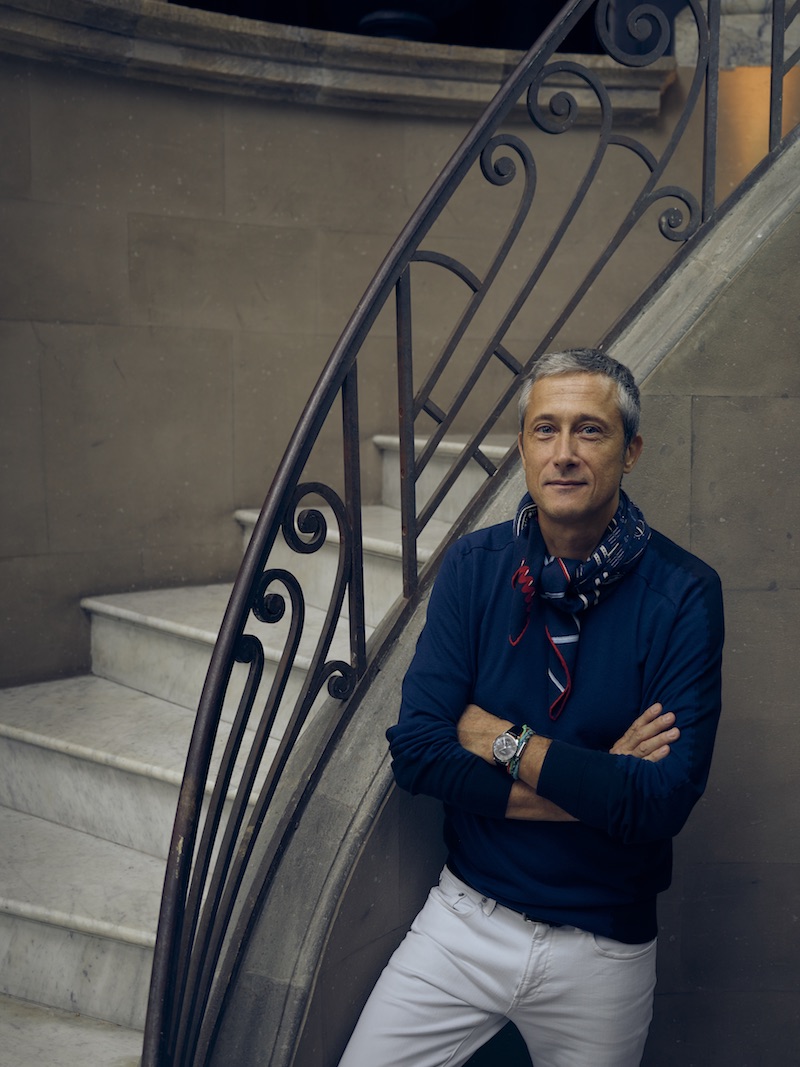The master of Hermès silks: Christophe Goineau
In Paris with Hermès creative director of mens' silks

Christophe Goineau is a candid interviewee. “Before joining Hermès, I did not know the brand that well. I was looking at Hermès as a house of traditions”, he admits when I ask him to recall his personal conception of the Parisian brand before he first joined Hermès over three decades ago. “Then, when I first joined the company in 1987, I experienced and witness the modernity of the house”
Goineau has since continued to uphold Hermès’ spirit of innovation. In 2011, he was appointed creative director of men’s silks, a category he infuses with creative daring founded in Hermès’ artisanal excellence and know-how. At the brand’s Lyonnaise workrooms – the heart of Hermès’ silk production lies here, in east central France – Goineau has tasked craftspeople to stamp silk with block prints championing traditional Indian techniques; elsewhere, printed scarves are over-dyed to achieve an ombre finish. To realise Goineau’s 2017 Caducée Rock Tie and Dye design, the Lyons team hand-tied finished scarfs with small knots which were then dipped into vivid dyes, each knot submerged individually. “We can spend several hours on small details that perhaps won’t be noticed at first glance, says Goineau, hinting at Hermès’ quality-standards. “but our clients will notice them when they wear our objects. They may also notice them when they put the scarf away for several years and [then] rediscover it and still have the same pleasure in wearing it. These small, sometimes invisible details that make the difference”
Initially, Goineau – then a 21 years old business school student – was hired by Hermès to complete a placement of six months. Post placement – and having evaded France’s then compulsory military service – Goineau found himself in search of employment; luckily, Hermès offered to extend his contract. It was while working with the brand’s tight-knit team that Goineau slowly found his calling. ”I had the chance to meet people who were completely devoted to the house“, he remembers. ”Passionate people – when you meet passionate people, they share their passion“.
The Week
Escape your echo chamber. Get the facts behind the news, plus analysis from multiple perspectives.

Sign up for The Week's Free Newsletters
From our morning news briefing to a weekly Good News Newsletter, get the best of The Week delivered directly to your inbox.
From our morning news briefing to a weekly Good News Newsletter, get the best of The Week delivered directly to your inbox.
In addition to leathers, silk has long been one of the pillars of Hermès’ heritage. German-born Thierry Hermès opened his first Parisian master workshop in 1837, specialising in award-winning harnesses and bridles. The company has remained family-run ever since: in turn, subsequent generations introduced Hermès saddles, sportswear (starting with a zipped leather golf jacket), accessories and jewellery. Today, there are 16 Hermès métiers, fields of specialism that include ready-to-wear, perfume, watches and from this March onwards, beauty.

Christophe Goineau, Hermès creative director of mens' silks
Jeu Des Omnibus Et Dames Blanches marked Hermès’ first foray into silk: named after a board game which required players to place bets on horse-drawn carriages – including Paris’ two-compartment Dames Blanches public omnibus – the 1937 creation used a circular woodcut pattern devised by artist Hugo Grygkar. At Hermès, luxury is approached with irreverence and playfulness. “We are a house of evolution and not a house of revolution”, says Goineau, who often visits the brand’s well-stocked archives for inspiration.
At his two Hermès’ offices – one lies at the maison’s storied base on Rue du Faubourg Saint-Honoré, the other in the Parisian suburb of Pantin, where Hermès’ set-up includes a fragrance laboratory manned by perfumer Christine Nagel and a cadre of bespoke tailors finishing Véronique Nichanian’s menswear collections – Goineau masterminds the many silk accessories that make up a gentleman’s wardrobe, from dinky pocket squares to bow ties and the brand’s signature diamond-shaped losanges scarves. Then, there are Hermès’ famous silk ties. Goineau tells me that during his Hermès tenure he has witnessed ties’ shift away from traditional dress codes to instead becoming an accessory of choice. “I remember my father telling me, ‘Don’t wear striped ties with striped shirts’”, he says. “Now, in Hermès’ stores we see more and more young guys buying ties for pleasure. When I was twenty, wearing a tie was seen as an obligation more than a personal choice and pleasure”.
A free daily email with the biggest news stories of the day – and the best features from TheWeek.com
Hermès takes pride in the creative freedom the brand’s teams and collaborators are given. “Our artists, designers, graphistes [graphic designers] enjoy a real freedom of creation”, says Goineau who has partnered with a list of international artists counting Elias Kafouros from Greece, Irish draughtsman Nigel Peake and Londoner Alice Shirley. At her Camden studio, Shirley has since 2012 been sketching an Hermès menagerie of big cats, bears, zebras and a Tyrannosaurus rex. Elsewhere, Nothing But A Dreamer features Maylis Vigouroux’ fairy-tale landscapes of castles, skyscraper and hot air balloons peopled by oversized whales and dragons. The intricate design is rendered in single tone prints. “We are a house of balance, of équilibre”, says Goineau who insists on allowing artists time to experiment and develop their ideas. “If they come back in two weeks’ time – I’m happy! Sometimes they come back three months after, sometimes a year. It does not matter if they need that time to create”
For this season’s Hermès Paris fashion week show, Goineau devised light-weight accessories fashioned from a cotton and silk mix and printed with accents of bright colour. This spring, the brand’s silk artisans have much reason to celebrate: a line of Carrés Doubles marks an new mastery of their craft, as all scarves are printed on each side with colour-variations of the same print. For men, the technique has given shape to orange and blue versions of C’est la Fête by Japanese artist Daisuke Nomura, which features a skeleton on horseback. Says Goineau. “ his is my playground: design, colour, material and shape. These are the four things I can change and play with – and [the possibilities are] endless”.
Portrait by: Fernando Marroquin
Still life by: Charlotte May
-
 Trump HHS slashes advised child vaccinations
Trump HHS slashes advised child vaccinationsSpeed Read In a widely condemned move, the CDC will now recommend that children get vaccinated against 11 communicable diseases, not 17
-
 Hegseth moves to demote Sen. Kelly over video
Hegseth moves to demote Sen. Kelly over videospeed read Retired Navy fighter pilot Mark Kelly appeared in a video reminding military service members that they can ‘refuse illegal orders’
-
 Delcy Rodríguez: Maduro’s second in command now running Venezuela
Delcy Rodríguez: Maduro’s second in command now running VenezuelaIn the Spotlight Rodríguez has held positions of power throughout the country